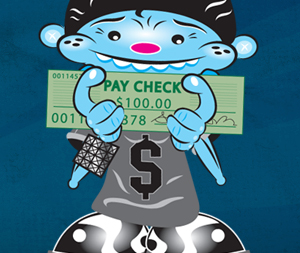Bankruptcy judges and lawyers step into the classroom to teach money management
"That's the most expensive t-shirt I've ever owned. I should probably have it framed," says Layla Elzner-Sislen, as she recalls the t-shirt she got for "free" just by applying for a credit card during her first days as a college student at the University of Texas.
Today Elzner-Sislen can laugh at her money management faux pas. She's since paid off the debt she ran up with that card and, as the program coordinator for the Texas Bar Association's MoneyWise program, she wants to see that other new high school graduates don't pay the same price.
This year, the MoneyWise Program, sponsored by the Bankruptcy Law Section of the state bar and the Consumer Information Foundation, is being rolled into San Antonio as a way of introducing high school students to personal financial management. The course was first introduced in 2005 in other Texas cities and has been met with great enthusiasm from educators.
"We're seeing younger and younger people falling into bankruptcy, and there seemed to be a need for a course for high school students about personal financial management," explains Elzner-Sislen.
More than 40,000 Texans filed for bankruptcy in 2007, an increase of nearly 6,000 from 2006. The state's bar association wants to reverse that trend by providing high school students with some basic financial education and a few cautionary tales about managing debt.
Legal coaching
Local bankruptcy attorneys and judges are volunteering their time, and will use a MoneyWise computer-based presentation to give students a standard overview of sound financial practices such as budgeting and goal setting. There is no cost for the schools or the students.
After the broad presentation, the local legal professionals then meet with students one-on-one to share their real-world stories about the impact of poor financial management. Topics include typical salaries for different types of jobs, the difference between secured and unsecured debt and general advice about how to spend within their means.
"It's not really a 'scared straight' kind of approach," says Elzner-Sislen. "We're not trying to scare them. There's not a lot of focus on bankruptcy, because that's what we're trying to prevent. We're stressing ways to make wise financial decisions."
Bankruptcy attorney Beth Smith, who's leading the initiative in San Antonio, says high school students are savvy, just inexperienced.
"They've never managed their own finances before. They see the sign that says 'Free t-shirt or pizza or Mp3 with application,' and they don't understand what that pizza is really going to cost them," Smith says. "And we're not out to bash the credit card companies either. They have their place. We just want to teach kids to be financially responsible across the board; saving money, budgeting, managing debt and not having to buy everything they see."
Smith began organizing presentations in San Antonio in the fall of 2007 and expects her committee of 12 local attorneys to start making presentations at local high schools this year. "We're lined up with the North East (Independent) School District (NEISD) already, and we'll be making our pitch to the SAISD (San Antonio Independent School District) this month," Smith says. "We've also been invited to go into Incarnate Word and St. Anthony high schools. We're gradually getting into all the school districts around town."
Real-life lessons
The Texas Essential Knowledge and Skills (TAKS) standards require a certain amount of financial education from kindergarten through 12th grade, according to Eric McGarrah, assistant director for social studies Pre-K/12 for NEISD. He sees the MoneyWise program as an effective adjunct to the district's economics curriculum.
"We have a personal finance literacy segment to our senior economics classes that lasts several weeks," he explains. "This is a good add-on to that. I like the way the MoneyWise presentation is set up because it addresses some key issues. The computer presentation is good. They talk about situations students are going to face in the next few years that will impact their financial future for years to come. I like that concept. I don't think a lot of adults even think about long-term ramifications when they're making financial decisions."
The program, which will be presented at all seven NEISD high schools, will reach at least 1,800 seniors. McGarrah expects the lower grades will also sign on, increasing that total by several hundred more.
Financing a degree
The presentation, though applicable to all students, is geared toward juniors and seniors. It encourages them to think carefully about the real cost of a college education and the definition of a student loan.
"That's an unsecured loan and there are ramifications to that," Elzner-Sislen says. "We're encouraging that kind of progressive planning. We want students to take the time to think about their financial choices and have the tools to understand what they're getting involved in. It's so easy to access funds and so easy to get a credit card; it's easy to dig a financial hole and hard to get out."
Statewide, since being introduced in 2005, the presentation has been made to approximately 60 Texas high school classes so far and has been widely embraced by educators. In 2006, the Texas Education Agency approved the use of the program as part of its economics literacy standards. We have local attorneys in every major city and some smaller towns going to schools. Teachers usually try to work the program in with their economics classes and financial management courses, but we've presented it to social studies classes, even English classes," Elzner-Sislen says.
Topics covered in the 27-screen computer presentation include: setting goals, budgeting, anticipating expenses, emergency planning, credit/debt management and credit reports/credit history.
The program has been endorsed locally by the San Antonio Bar Association, the San Antonio chapter of the Federal Bar Association, the Bexar County Women's Bar Association, and the San Antonio Young Lawyers Association.
Smith, a creditor's lawyer today, was a debtor's lawyer in the '80s so she's seen both sides of the equation, as have most of her colleagues. "Everyone on our committee knows how easy it is to get into debt. This is the bankruptcy council trying to educate these young people before they start getting those credit card applications," Smith says.
NEISD's McGarrah says the program breaks down broad economic lingo into easy, understandable chunks.
"The program talks about setting goals," McGarrah explains. "And the bottom line to that is often tied to money. You have to have money to move toward those goals whether they be a higher education or a house. So they talk about budgeting and average salaries. They talk about gross income and net income so kids understand that what's on your paycheck isn't what you take home.
He adds, "They have a really neat little graph that explains if you save $250 a month at 5 percent for 40 years you'll end up with $375,000. I wish someone had told me that when I was in high school."
Consumer bankrupcy filings in Texas
2004: 91,369
2005: 119,650
2006: 34, 340
2007: 40,311
Randy Lankford is a San Antonio free-lance writer. |





